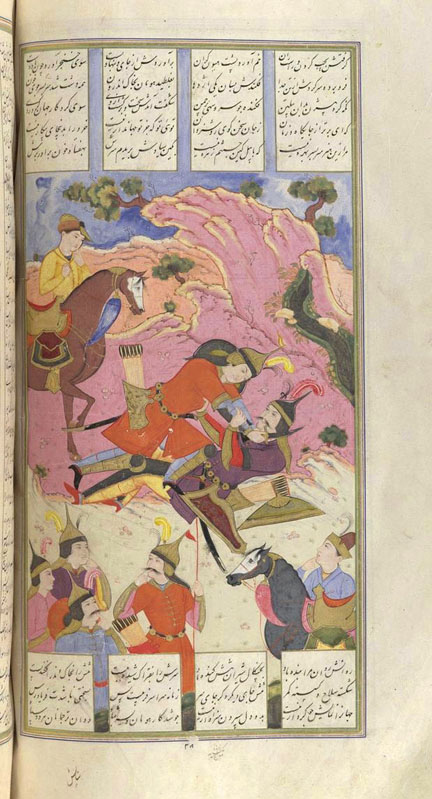Combat of Bižan and Humān
The two protagonists are portrayed in hand-to-hand combat near the center of the composition. Bižan has already attained the advantage, having been able to wrestle his opponent to the ground, where with one knee pressed into Humān’s midsection, he grapples to finish him off with his dagger. Humān struggles to constrain Bižan’s arms, but the end is in sight. Both warriors are dressed nearly identical: pointed steel helmets adossed with feathers, leg guards, boots, and knee length coats bound at the waist with a belt from which is suspended a sword, bowcase, and quivers. Only the colors of the clothing and feathers vary, as well as the location of their shields: Bižan’s is strapped to his back, Humān’s has fallen to the ground. The forequarters of two riderless horses and their respective grooms, each with a forefinger to the lips in a sign of astonishment, are juxtaposed, one in the upper left, the other in the lower right. Four other warriors, dressed in coats and pointed helmets, stand witnessing the event from the left foreground, their lower extremities cropped by the frame. It is not evident whether they are Iranian or Turānian. The setting is a barren hillside that rises to a craggy rock outcropping at the top. Several small bushes grow near the pinnacle, and a small stream trickles down on the far right, A wash sky of the Moʿin type appears in the far distance.
Painting: 23.6 x 16.5 cm. The text is written in four columns above and below the painting, with a rectangular frame enclosing painting and text. The miniscule signature, raqam-e kamina fażl ʿali, is inscribed on the sky at the top of the painting, in addition to the signature of Moʿin, raqam zad kamina moʿin-e moṣavver, written in the center of the lower margin. The painting is attributed by Jackson and Yohannan to Fażl ʿAli, and by Robinson to Moʿin with the assistance of Fażl ʿAli. The painting is executed in excellent Moʿin style, and the detailing indistinguishable from the master’s other work. Yet the signature of Fażl ¯Ali suggests that Moʿin had assistance in the preparation of this painting. However, the role of the lesser artist must have been such that his contribution is inseparable from his master’s.
For another Moʿin painting from the same episode, slightly later in the narrative, see Ms. C, folio 188.
Painting references:
J&Y_1914, p.37 no.29 (not ill.).
Robinson, Cochran4_1972, p.79, no.29 (not ill.).
Cambridge Shahnameh Project
Text references: Warner, IV, pp.49-50; Mohl, III, p.383.
Robert Eng
Last Updated: February 2, 2011 | Originally published: June 18, 2003
